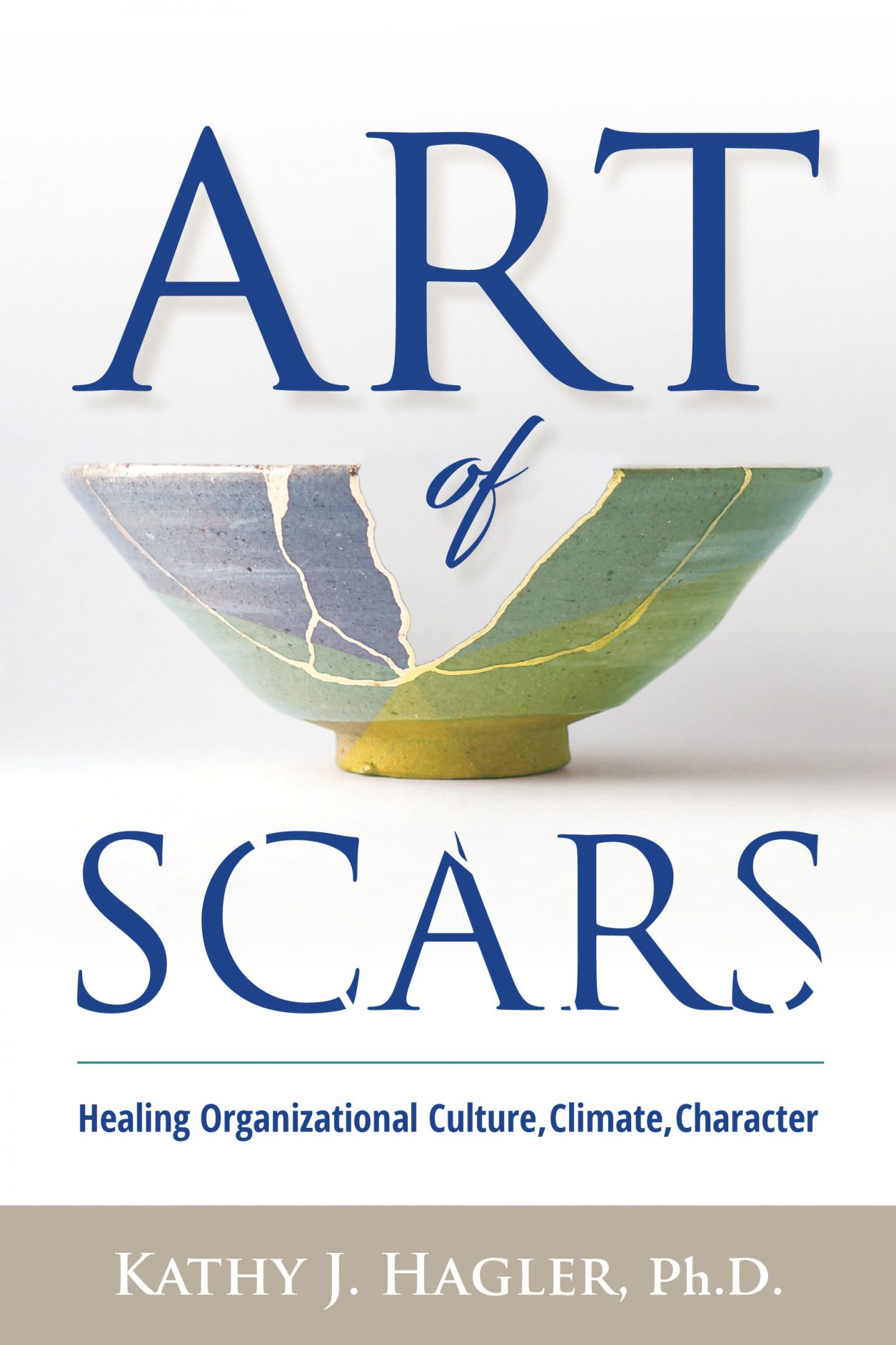The Japanese kintsugi[i] vase is the perfect metaphor for healing scars in both people and organizations. The first time I saw one I was amazed that its golden joinery transformed something useless—broken shards pottery—into something so beautiful it nearly took my breath away.
I knew that the art of kintsugi held valuable lessons on healing, so I found a kintsugi artist and consultant, Kati, in my tiny town. I told her I had witnessed many wounds and scars in people and organizations. Kati said she could teach me how the process can be healing to individuals.
Kati put the two inexpensive vases in two plastic bags and instructed me to drop them on the pavement. This seemed dramatic and unnecessary, since I had already begun to appreciate their imperfections. All that remained were sharp shards of cracked clay sticking through the plastic bag.
My spirit felt broken, and I silently questioned if I had made a big mistake. The broken vases reflected how I felt every day, as if the world were chipping away at me, leaving me vulnerable and imperfect—pieces of my former self. Then the five-step process began.
First, I deposited the jagged pieces on the table. One vase was almost pulverized; the other broken into twelve pieces, with a third of the base still intact. I felt hopeless. As prickles of anxiety started up my neck, I wondered how we could make something beautiful and valuable from the remains.
Pointing to the vase still partially intact, she suggested we get started. I simply looked back at her, confused and anxious. I suggested I watch her work, but she smiled and said, “The art is in the creation. It captures your meaning, your ideas, and your dreams.”
I realized that in order to benefit from kintsugi I would have to do it myself. And yet I continued to resist. I was afraid as we moved to Step Two: summoning the courage to calm my fears and face the task. As I began gingerly cleaning the pieces and cautiously moving the sharp bits around on the table, my courage grew. With Kati’s encouragement, I slowly felt capable and in control. Then she suggested I prepare the shards by cleaning them and exploring their shapes, textures, and sizes. Kati told me how beautiful the pieces were. I found it fascinating that brokenness was beautiful to her.
I learned that the gold lacquer dries quickly, so the order used to reassemble the vase was important. This artistic process required making informed decisions and choices that would ensure the best healing. I engaged in Step Three: I asked for help. Kati show me how to think about making kintsugi art. I was comforting, knowing I wasn’t alone.
In Step Four, my mindset shifted: These were pieces of a puzzle, not symbols of brokenness. Gently placing the large and small pieces together to try to find the central piece, I found the piece that most influenced the strength of the vase and began to see where the other pieces would fit. I felt inspired, unafraid, and almost lightheaded. about the art as, step by step, Kati provided immediate, authentic feedback and encouragement. Beginning with the central piece, I traced the thinnest lines of lacquer on the broken edges, caressing and fully embracing each scar.
Finally, I observed the beauty of my golden-joined vase. I now felt proud of the scars rather than shamed by them. I held a masterpiece, created from something quite broken. Its scars were strong and golden. It looked as if light were shining through the spaces between the broken pieces, as if light were shining through the scars. I shared with her how I felt and celebrated the flow of transforming fear to light.
Looking at the kintsugi vase I had made, I saw myself. I had felt physically, emotionally, and spiritually broken by my own life experiences. But now I felt my wounds could heal and, in healing into golden scars, that I could be whole—even improved. A two-dollar vase, broken and mended through the process of kintsugi, could be worth hundreds of dollars. I, too, was better person because of my scars.
Art of Scars is the artistic process—using the acronym SCARS—of moving from wounded to healed. I followed these steps when learning kintsugi—and have taken organizations and individuals through the SCARS process for decades to help in their healing:
- S: Stop broken thoughts and feelings.
- C: Courageously calm fear.
- A: Allow connection with others.
- R: Reinvent actions and take first step.
- S: Share your story.
See yourself as a kintsugi pottery piece. Forgive yourself for your past mistakes and see them as life lessons. Accept your defects and see them as what makes you unique. Accept, embrace and be your most authentic self. Authentic people have a healthy relationship with their emotions, and they have control over them.
Since I have dealt with brokenness all my life, I realized I had developed a unique mindset about wounds. Wounds remind us to be conscious of what happened (don’t bury it), be kind when we are going through transition, take responsibility for our healing, find the silver lining, and get right back up. Like people, organizations can intentionally heal because they are inherently resilient.
The message is: There is an art to your scars. You can heal. Accept and embrace your brokenness and question its intent. Listen. Notice your stages of healing and invite those lessons to become part of your subconscious mind. Once in that part of the mind, they will become habits for you to use with future wounds. Choose to be curious and motivated. Create your vision, your direction, understand your purpose, and be healed. Your healed body, mind, and spirit will provide the roadmap and guiding light for others. There will be light shining through the your scars.
Kathy Hagler, PhD is the author of ART OF SCARS (Sept, 202) and founder of K2OHSOLUTIONS. Known as an organizational healer in the industry, Dr. Hagler is a pioneer in the field of organizational development. To learn more about Dr. Hagler or ART OF SCARS, go to www.kathyhagler.com.
is the author of ART OF SCARS (Sept, 202) and founder of K2OHSOLUTIONS. Known as an organizational healer in the industry, Dr. Hagler is a pioneer in the field of organizational development. To learn more about Dr. Hagler or ART OF SCARS, go to www.kathyhagler.com.
[i] Pronounced keen-tsoo-gee. Note that the ts is audible, and the g is hard, as in gone. All three syllables are given equal emphasis.




















